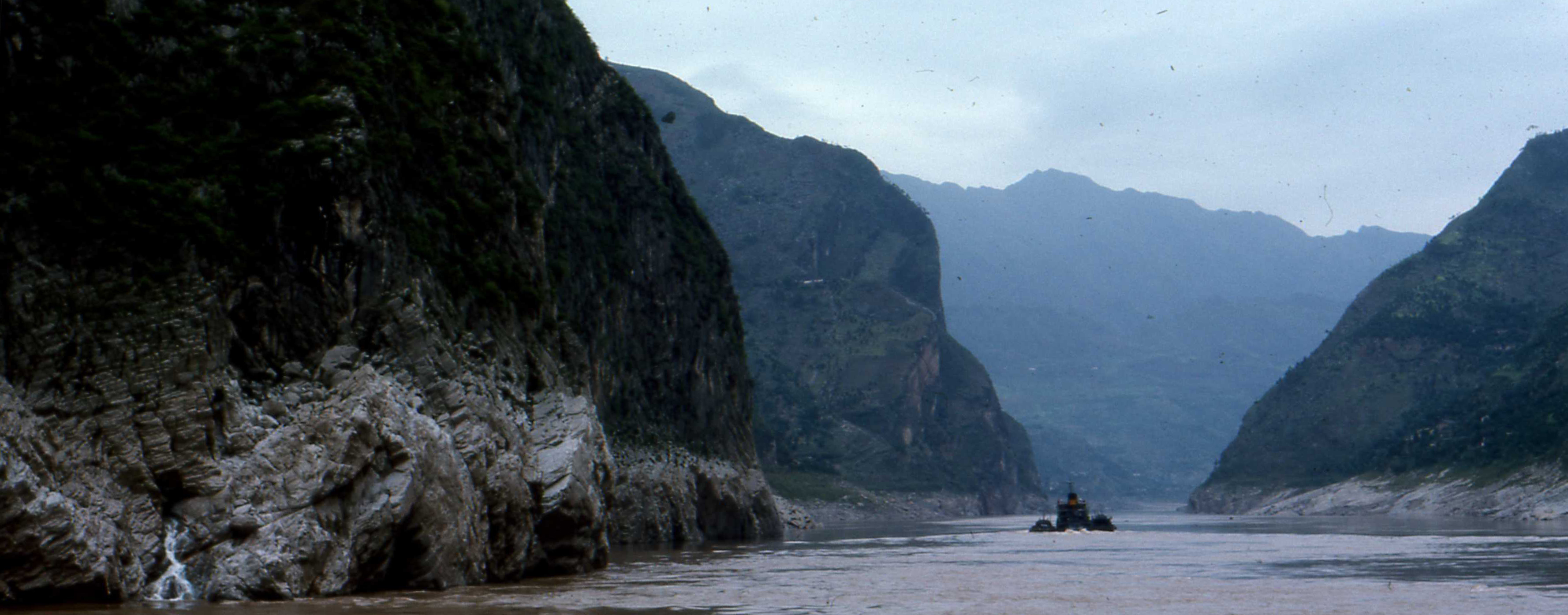-
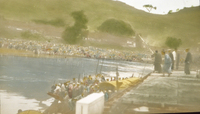 Refugees Trying to Cross the Min River
Refugees Trying to Cross the Min River Taken from the top of the steamboat that Graham was on. A crowded Chinese wooden boat is below alongside them. On the shoreline across the river there is a huge crowd of refugees, which Graham explains are in a retreating army.
-
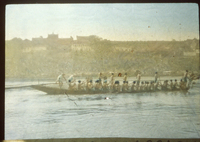 Chinese Dragon Boat at the Annual Dragon Boat Festival
Chinese Dragon Boat at the Annual Dragon Boat Festival A long narrow boat with many men in it rowing and poling. It looks like they are racing. Graham's caption draws attention to a dragon's head, but it is not clearly visible in the image. There are large Chinese-style buildings on the shoreline in the background.
-
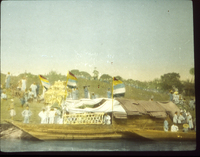 Festival Boat at Tuan-yang Festival, Suifu
Festival Boat at Tuan-yang Festival, Suifu Small wooden boat decorated with a large golden dragon or lion head and three "Five Races Under One Union" flags of the Republic of China. This latter means that this image was taken before 1928 when the Guomindang gained control over all China and used their own flag. A crowd is gathered on the shore to watch.
-
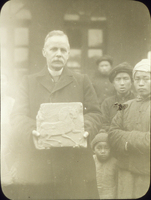 Rev. Thomas Torrance with a Han Dynasty Brick
Rev. Thomas Torrance with a Han Dynasty Brick Thomas Torrance stands outdoors holding a sandstone brick with a relief of a prancing horse on it. The brick is about a foot square. There are a small group of Chinese looking on, including one small child.
-
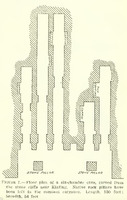 Diagram of Interior of Cave Tombs
Diagram of Interior of Cave Tombs Diagram of a six chamber cave tomb, showing the two pillars in the entranceway and the coffin alcoves within the chambers. The chambers are of different lengths, from two very deep ones to one very shallow one.
-
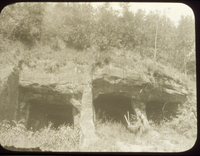 Cave Tomb Entrance with Chinese Man
Cave Tomb Entrance with Chinese Man Three square-shaped cave entrances are in a row. A Chinese man walks away from them with a pair of large baskets. The entrances appear to be about twice the height of the man, and just as wide. A forest of trees grows above the caves.
-
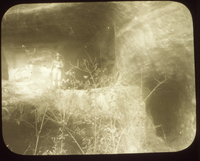 Cave Tomb Entrance with Missionary
Cave Tomb Entrance with Missionary Three cave entrances are clearly visible. Their large scale is apparent by the unidentified missionary that stands on the top level of entrances. There is an alcove next to the missionary that might have a carved relief in it.
-
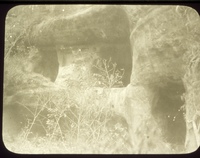 Opening to Multilevel Cave Tomb
Opening to Multilevel Cave Tomb The entrance to cave tombs on three distinct levels. On the right is a tall entranceway between the height of two levels of entrances to the left. There appear to be four entrances, but the lower ones are obscured by foliage. There is an alcove between the two entrances at the top level that might have a carved relief in it.
-
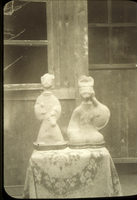 Clay Human Figures from Cave Tomb
Clay Human Figures from Cave Tomb Two clay statues, a man (left) and a woman (right), stand upon a small lace-covered table. From the size of the window behind them, they appear to be about a foot tall. The man stands with unidentified implements in both hands. He wears a floor-length gown. He has either long coiffed hair or wears a hat. He appears to be smiling. The woman is seated in a kneeling position with her left hand held up to her face. She wears the same type of robe as the man with a turban style hat.
-
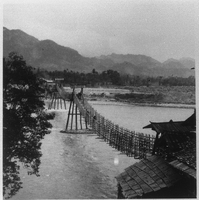 Anlan Bridge Looking West
Anlan Bridge Looking West Taken from the eastern shoreline looking over the Inner River toward the west. Bamboo and stone basketwork can be seen on the shoreline of the island separates the Inner and Outer Rivers. Mountain ranges are in the background. Several people are on the bridge.
-
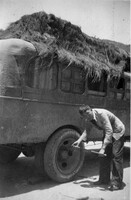 Tire Problems on the Burma Road
Tire Problems on the Burma Road The driver of John Stinson's truck uses a lug wrench to fix the rear passenger tire after it has broken down. The baggage on the top of the truck is covered with tarps made from yak hides.
-
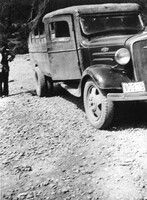 Frequent Breakdowns on the Burma Road
Frequent Breakdowns on the Burma Road One of the eight trucks in the Allen-Stinson convey is stopped for repairs. One can see the license plate and the Chevrolet logo on the truck. A man stands half out of the frame to the left.
-
 The Road from Kunming to Chungking
The Road from Kunming to Chungking At a tight curve in the Burma Road, Stinson takes a photo over the flimsy wooden railing at the side of the road. Down in the valley, one can see the road descending alongside terraced fields.
-
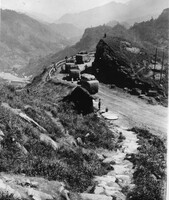 Stewart Allen Brings Up the Rear
Stewart Allen Brings Up the Rear Five of the eight trucks in Allen's and Stinson's care have stopped, probably at a roadside restaurant (note the thatched roof in the left foreground). Stinson has climbed a rocky path to take the photo looking down upon the scene. On the curve of the road, a flimsy railing separates vehicles from the steep mountainside beyond it.
-
 Twenty-four Switchbacks
Twenty-four Switchbacks Landscape scenery showing a few hairpin turns on the Burma Road. This section of the road is known as The Stilwell Twenty-Four due to the number of switchbacks or hairpin turns going up the mountain. General Joseph Stilwell must have used that road when he led the OSS during WWII. A large section of it is currently preserved as a heritage site.
-
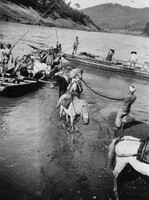 Horses Ford a River
Horses Ford a River Horses are disembarking from a boat after crossing a river. They are wearing saddles and baskets over their muzzles, suggesting that they will be used for military purposes rather than as pack animals. Most likely, they are not part of the Stinson and Allen convoy, but rather encountered along the way.
-
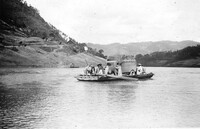 Fording the River 2
Fording the River 2 A truck with tarps made from yak skins covering the baggage on top is on a barge crossing a river. Many men are using a huge oar to propel the barge across the river. A road and buildings can be seen on the mountainside in the background.
-
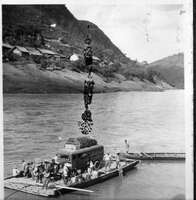 Fording the River 3
Fording the River 3 Stewart Allen stands on the deck of a barge with one of their eight trucks on it. The baggage on top of the truck is covered with tarps made from yak skins. There are many workmen on the barge, one of whom is using a pole to push the barge away from the shallow water near the shore. There is a canoe-like boat pulled up alongside the barge.
-
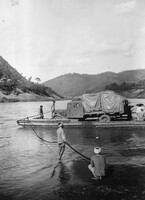 Fording the River 1
Fording the River 1 Two men in the foreground hold a rope to keep the barge steady as five other men are on the barge to help load a truck onto it. The truck is covered with a tarp.
-
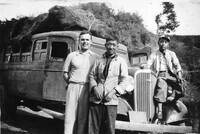 John Stinson with One of the Drivers
John Stinson with One of the Drivers John Stinson poses with one of the drivers and another man in front of one of the eight trucks in his and Stewart Allen's convoy. One of the men sits on the front end of the truck. The baggage on top of the truck is covered with tarps made from yak skins.
-
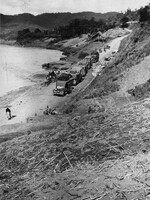 John Stinson and Stewart Allen with Five Lorries
John Stinson and Stewart Allen with Five Lorries Five of the eight trucks in Allen's and Stinson's care travel in a convoy along a dirt road next to a lake or river. The baggage on the tops of the trucks are covered with tarps made from yak skins. The drivers have stopped at a roadside restaurant for a lunch break.
-
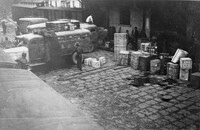 Loading the Trucks in Kunming
Loading the Trucks in Kunming Scene at the railway depot in Kunming where John Stinson and Steward Allen are transferring the baggage from the train onto the trucks that they have hired. One man sits atop a truck to load boxes onto the truck top. A great pile of wooden boxes awaits loading. They hired altogether eight trucks to carry all the missionary baggage and supplies in their care.
-
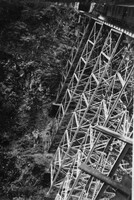 Train trestle from Hanoi to Kunming
Train trestle from Hanoi to Kunming Taken from the train on the French Indochina railway as it crosses a high bridge across a valley.
-
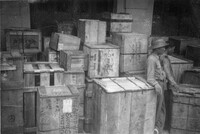 Customs in Haiphong
Customs in Haiphong Missionary baggage in the care of Stewart Allen and John Stinson at the customs house with two men, one in a pith helmet. In the foreground one of the boxes is addressed to Miss Astrid Peterson, an American Baptist missionary stationed at Suifu (Yibin), Sichuan.
-
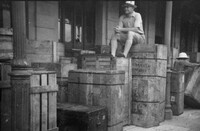 Stewart Allen Guarding the Missionary Cargo in Haiphong
Stewart Allen Guarding the Missionary Cargo in Haiphong Stewart Allen sits on top of a large box labelled "Chungking" amidst many wooden boxes of which he and John Stinson are in charge. The boxes and trunks are in front of a large brick building with columns. Another man is behind Allen wearing a pith helmet.
 Refugees Trying to Cross the Min River Taken from the top of the steamboat that Graham was on. A crowded Chinese wooden boat is below alongside them. On the shoreline across the river there is a huge crowd of refugees, which Graham explains are in a retreating army.
Refugees Trying to Cross the Min River Taken from the top of the steamboat that Graham was on. A crowded Chinese wooden boat is below alongside them. On the shoreline across the river there is a huge crowd of refugees, which Graham explains are in a retreating army. Chinese Dragon Boat at the Annual Dragon Boat Festival A long narrow boat with many men in it rowing and poling. It looks like they are racing. Graham's caption draws attention to a dragon's head, but it is not clearly visible in the image. There are large Chinese-style buildings on the shoreline in the background.
Chinese Dragon Boat at the Annual Dragon Boat Festival A long narrow boat with many men in it rowing and poling. It looks like they are racing. Graham's caption draws attention to a dragon's head, but it is not clearly visible in the image. There are large Chinese-style buildings on the shoreline in the background. Festival Boat at Tuan-yang Festival, Suifu Small wooden boat decorated with a large golden dragon or lion head and three "Five Races Under One Union" flags of the Republic of China. This latter means that this image was taken before 1928 when the Guomindang gained control over all China and used their own flag. A crowd is gathered on the shore to watch.
Festival Boat at Tuan-yang Festival, Suifu Small wooden boat decorated with a large golden dragon or lion head and three "Five Races Under One Union" flags of the Republic of China. This latter means that this image was taken before 1928 when the Guomindang gained control over all China and used their own flag. A crowd is gathered on the shore to watch. Rev. Thomas Torrance with a Han Dynasty Brick Thomas Torrance stands outdoors holding a sandstone brick with a relief of a prancing horse on it. The brick is about a foot square. There are a small group of Chinese looking on, including one small child.
Rev. Thomas Torrance with a Han Dynasty Brick Thomas Torrance stands outdoors holding a sandstone brick with a relief of a prancing horse on it. The brick is about a foot square. There are a small group of Chinese looking on, including one small child. Diagram of Interior of Cave Tombs Diagram of a six chamber cave tomb, showing the two pillars in the entranceway and the coffin alcoves within the chambers. The chambers are of different lengths, from two very deep ones to one very shallow one.
Diagram of Interior of Cave Tombs Diagram of a six chamber cave tomb, showing the two pillars in the entranceway and the coffin alcoves within the chambers. The chambers are of different lengths, from two very deep ones to one very shallow one. Cave Tomb Entrance with Chinese Man Three square-shaped cave entrances are in a row. A Chinese man walks away from them with a pair of large baskets. The entrances appear to be about twice the height of the man, and just as wide. A forest of trees grows above the caves.
Cave Tomb Entrance with Chinese Man Three square-shaped cave entrances are in a row. A Chinese man walks away from them with a pair of large baskets. The entrances appear to be about twice the height of the man, and just as wide. A forest of trees grows above the caves. Cave Tomb Entrance with Missionary Three cave entrances are clearly visible. Their large scale is apparent by the unidentified missionary that stands on the top level of entrances. There is an alcove next to the missionary that might have a carved relief in it.
Cave Tomb Entrance with Missionary Three cave entrances are clearly visible. Their large scale is apparent by the unidentified missionary that stands on the top level of entrances. There is an alcove next to the missionary that might have a carved relief in it. Opening to Multilevel Cave Tomb The entrance to cave tombs on three distinct levels. On the right is a tall entranceway between the height of two levels of entrances to the left. There appear to be four entrances, but the lower ones are obscured by foliage. There is an alcove between the two entrances at the top level that might have a carved relief in it.
Opening to Multilevel Cave Tomb The entrance to cave tombs on three distinct levels. On the right is a tall entranceway between the height of two levels of entrances to the left. There appear to be four entrances, but the lower ones are obscured by foliage. There is an alcove between the two entrances at the top level that might have a carved relief in it. Clay Human Figures from Cave Tomb Two clay statues, a man (left) and a woman (right), stand upon a small lace-covered table. From the size of the window behind them, they appear to be about a foot tall. The man stands with unidentified implements in both hands. He wears a floor-length gown. He has either long coiffed hair or wears a hat. He appears to be smiling. The woman is seated in a kneeling position with her left hand held up to her face. She wears the same type of robe as the man with a turban style hat.
Clay Human Figures from Cave Tomb Two clay statues, a man (left) and a woman (right), stand upon a small lace-covered table. From the size of the window behind them, they appear to be about a foot tall. The man stands with unidentified implements in both hands. He wears a floor-length gown. He has either long coiffed hair or wears a hat. He appears to be smiling. The woman is seated in a kneeling position with her left hand held up to her face. She wears the same type of robe as the man with a turban style hat. Anlan Bridge Looking West Taken from the eastern shoreline looking over the Inner River toward the west. Bamboo and stone basketwork can be seen on the shoreline of the island separates the Inner and Outer Rivers. Mountain ranges are in the background. Several people are on the bridge.
Anlan Bridge Looking West Taken from the eastern shoreline looking over the Inner River toward the west. Bamboo and stone basketwork can be seen on the shoreline of the island separates the Inner and Outer Rivers. Mountain ranges are in the background. Several people are on the bridge. Tire Problems on the Burma Road The driver of John Stinson's truck uses a lug wrench to fix the rear passenger tire after it has broken down. The baggage on the top of the truck is covered with tarps made from yak hides.
Tire Problems on the Burma Road The driver of John Stinson's truck uses a lug wrench to fix the rear passenger tire after it has broken down. The baggage on the top of the truck is covered with tarps made from yak hides. Frequent Breakdowns on the Burma Road One of the eight trucks in the Allen-Stinson convey is stopped for repairs. One can see the license plate and the Chevrolet logo on the truck. A man stands half out of the frame to the left.
Frequent Breakdowns on the Burma Road One of the eight trucks in the Allen-Stinson convey is stopped for repairs. One can see the license plate and the Chevrolet logo on the truck. A man stands half out of the frame to the left. The Road from Kunming to Chungking At a tight curve in the Burma Road, Stinson takes a photo over the flimsy wooden railing at the side of the road. Down in the valley, one can see the road descending alongside terraced fields.
The Road from Kunming to Chungking At a tight curve in the Burma Road, Stinson takes a photo over the flimsy wooden railing at the side of the road. Down in the valley, one can see the road descending alongside terraced fields. Stewart Allen Brings Up the Rear Five of the eight trucks in Allen's and Stinson's care have stopped, probably at a roadside restaurant (note the thatched roof in the left foreground). Stinson has climbed a rocky path to take the photo looking down upon the scene. On the curve of the road, a flimsy railing separates vehicles from the steep mountainside beyond it.
Stewart Allen Brings Up the Rear Five of the eight trucks in Allen's and Stinson's care have stopped, probably at a roadside restaurant (note the thatched roof in the left foreground). Stinson has climbed a rocky path to take the photo looking down upon the scene. On the curve of the road, a flimsy railing separates vehicles from the steep mountainside beyond it. Twenty-four Switchbacks Landscape scenery showing a few hairpin turns on the Burma Road. This section of the road is known as The Stilwell Twenty-Four due to the number of switchbacks or hairpin turns going up the mountain. General Joseph Stilwell must have used that road when he led the OSS during WWII. A large section of it is currently preserved as a heritage site.
Twenty-four Switchbacks Landscape scenery showing a few hairpin turns on the Burma Road. This section of the road is known as The Stilwell Twenty-Four due to the number of switchbacks or hairpin turns going up the mountain. General Joseph Stilwell must have used that road when he led the OSS during WWII. A large section of it is currently preserved as a heritage site. Horses Ford a River Horses are disembarking from a boat after crossing a river. They are wearing saddles and baskets over their muzzles, suggesting that they will be used for military purposes rather than as pack animals. Most likely, they are not part of the Stinson and Allen convoy, but rather encountered along the way.
Horses Ford a River Horses are disembarking from a boat after crossing a river. They are wearing saddles and baskets over their muzzles, suggesting that they will be used for military purposes rather than as pack animals. Most likely, they are not part of the Stinson and Allen convoy, but rather encountered along the way. Fording the River 2 A truck with tarps made from yak skins covering the baggage on top is on a barge crossing a river. Many men are using a huge oar to propel the barge across the river. A road and buildings can be seen on the mountainside in the background.
Fording the River 2 A truck with tarps made from yak skins covering the baggage on top is on a barge crossing a river. Many men are using a huge oar to propel the barge across the river. A road and buildings can be seen on the mountainside in the background. Fording the River 3 Stewart Allen stands on the deck of a barge with one of their eight trucks on it. The baggage on top of the truck is covered with tarps made from yak skins. There are many workmen on the barge, one of whom is using a pole to push the barge away from the shallow water near the shore. There is a canoe-like boat pulled up alongside the barge.
Fording the River 3 Stewart Allen stands on the deck of a barge with one of their eight trucks on it. The baggage on top of the truck is covered with tarps made from yak skins. There are many workmen on the barge, one of whom is using a pole to push the barge away from the shallow water near the shore. There is a canoe-like boat pulled up alongside the barge. Fording the River 1 Two men in the foreground hold a rope to keep the barge steady as five other men are on the barge to help load a truck onto it. The truck is covered with a tarp.
Fording the River 1 Two men in the foreground hold a rope to keep the barge steady as five other men are on the barge to help load a truck onto it. The truck is covered with a tarp. John Stinson with One of the Drivers John Stinson poses with one of the drivers and another man in front of one of the eight trucks in his and Stewart Allen's convoy. One of the men sits on the front end of the truck. The baggage on top of the truck is covered with tarps made from yak skins.
John Stinson with One of the Drivers John Stinson poses with one of the drivers and another man in front of one of the eight trucks in his and Stewart Allen's convoy. One of the men sits on the front end of the truck. The baggage on top of the truck is covered with tarps made from yak skins. John Stinson and Stewart Allen with Five Lorries Five of the eight trucks in Allen's and Stinson's care travel in a convoy along a dirt road next to a lake or river. The baggage on the tops of the trucks are covered with tarps made from yak skins. The drivers have stopped at a roadside restaurant for a lunch break.
John Stinson and Stewart Allen with Five Lorries Five of the eight trucks in Allen's and Stinson's care travel in a convoy along a dirt road next to a lake or river. The baggage on the tops of the trucks are covered with tarps made from yak skins. The drivers have stopped at a roadside restaurant for a lunch break. Loading the Trucks in Kunming Scene at the railway depot in Kunming where John Stinson and Steward Allen are transferring the baggage from the train onto the trucks that they have hired. One man sits atop a truck to load boxes onto the truck top. A great pile of wooden boxes awaits loading. They hired altogether eight trucks to carry all the missionary baggage and supplies in their care.
Loading the Trucks in Kunming Scene at the railway depot in Kunming where John Stinson and Steward Allen are transferring the baggage from the train onto the trucks that they have hired. One man sits atop a truck to load boxes onto the truck top. A great pile of wooden boxes awaits loading. They hired altogether eight trucks to carry all the missionary baggage and supplies in their care. Train trestle from Hanoi to Kunming Taken from the train on the French Indochina railway as it crosses a high bridge across a valley.
Train trestle from Hanoi to Kunming Taken from the train on the French Indochina railway as it crosses a high bridge across a valley. Customs in Haiphong Missionary baggage in the care of Stewart Allen and John Stinson at the customs house with two men, one in a pith helmet. In the foreground one of the boxes is addressed to Miss Astrid Peterson, an American Baptist missionary stationed at Suifu (Yibin), Sichuan.
Customs in Haiphong Missionary baggage in the care of Stewart Allen and John Stinson at the customs house with two men, one in a pith helmet. In the foreground one of the boxes is addressed to Miss Astrid Peterson, an American Baptist missionary stationed at Suifu (Yibin), Sichuan. Stewart Allen Guarding the Missionary Cargo in Haiphong Stewart Allen sits on top of a large box labelled "Chungking" amidst many wooden boxes of which he and John Stinson are in charge. The boxes and trunks are in front of a large brick building with columns. Another man is behind Allen wearing a pith helmet.
Stewart Allen Guarding the Missionary Cargo in Haiphong Stewart Allen sits on top of a large box labelled "Chungking" amidst many wooden boxes of which he and John Stinson are in charge. The boxes and trunks are in front of a large brick building with columns. Another man is behind Allen wearing a pith helmet.